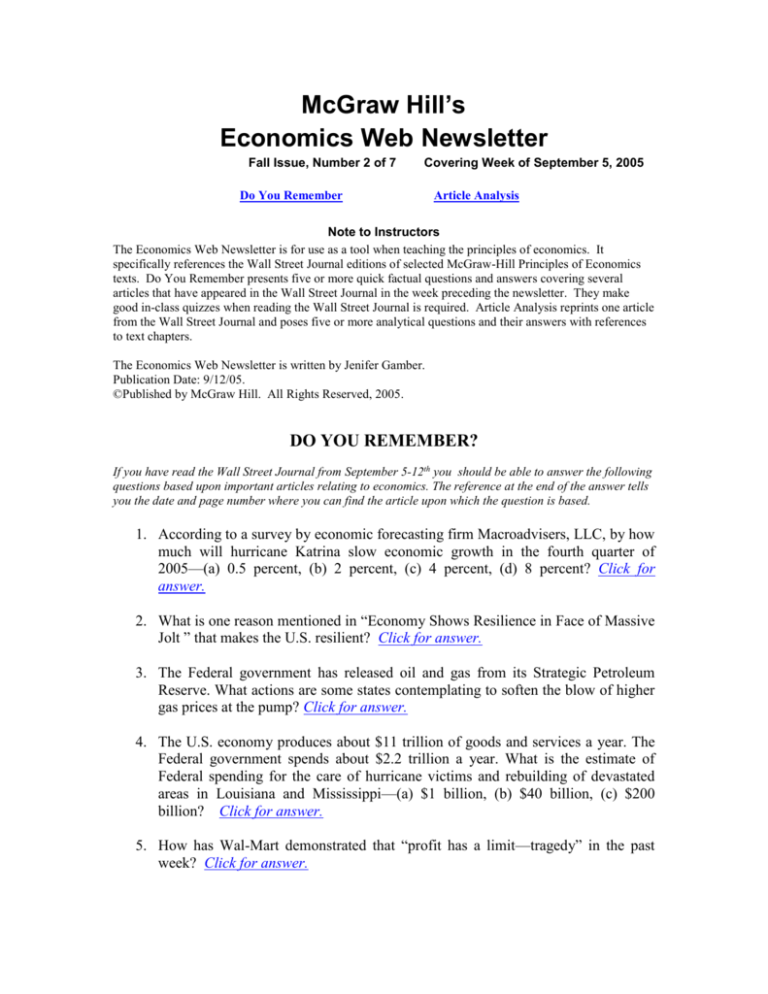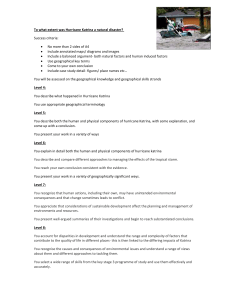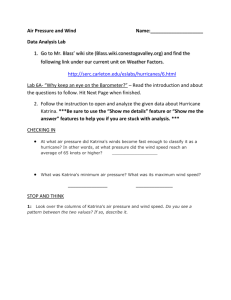
McGraw Hill’s
Economics Web Newsletter
Fall Issue, Number 2 of 7
Covering Week of September 5, 2005
Do You Remember
Article Analysis
Note to Instructors
The Economics Web Newsletter is for use as a tool when teaching the principles of economics. It
specifically references the Wall Street Journal editions of selected McGraw-Hill Principles of Economics
texts. Do You Remember presents five or more quick factual questions and answers covering several
articles that have appeared in the Wall Street Journal in the week preceding the newsletter. They make
good in-class quizzes when reading the Wall Street Journal is required. Article Analysis reprints one article
from the Wall Street Journal and poses five or more analytical questions and their answers with references
to text chapters.
The Economics Web Newsletter is written by Jenifer Gamber.
Publication Date: 9/12/05.
©Published by McGraw Hill. All Rights Reserved, 2005.
DO YOU REMEMBER?
If you have read the Wall Street Journal from September 5-12th you should be able to answer the following
questions based upon important articles relating to economics. The reference at the end of the answer tells
you the date and page number where you can find the article upon which the question is based.
1. According to a survey by economic forecasting firm Macroadvisers, LLC, by how
much will hurricane Katrina slow economic growth in the fourth quarter of
2005—(a) 0.5 percent, (b) 2 percent, (c) 4 percent, (d) 8 percent? Click for
answer.
2. What is one reason mentioned in “Economy Shows Resilience in Face of Massive
Jolt ” that makes the U.S. resilient? Click for answer.
3. The Federal government has released oil and gas from its Strategic Petroleum
Reserve. What actions are some states contemplating to soften the blow of higher
gas prices at the pump? Click for answer.
4. The U.S. economy produces about $11 trillion of goods and services a year. The
Federal government spends about $2.2 trillion a year. What is the estimate of
Federal spending for the care of hurricane victims and rebuilding of devastated
areas in Louisiana and Mississippi—(a) $1 billion, (b) $40 billion, (c) $200
billion? Click for answer.
5. How has Wal-Mart demonstrated that “profit has a limit—tragedy” in the past
week? Click for answer.
6. New Orleans was an important distribution site for the raw materials for steel. As
a result of the destruction caused by hurricane Katrina, what is expected to happen
to steel prices in the next few months? Click for answer.
7. What is the main way hurricane Katrina is hurting foreign economies? Click for
answer.
8. In the opinion column, an article supports price gouging. What is their argument?
Click for answer.
9. How is it that the effects of hurricane Katrina are presenting a dilemma for the
Federal Reserve Bank? Click for answer.
ANSWERS TO “DO YOU REMEMBER?” QUESTIONS
1. (a) 0.5%. Instead of growing at an annual rate of 4% in the fourth quarter,
economists now expect the economy to grow at an annual rate of 3.5%. (See
“Economy Shows Resilience in Face of Massive Jolt ” September 6, page A1.)
2. The article mentioned a number. Here are a few: the U.S. economy is less
dependent on oil, the U.S. has released oil and gas from its Strategic Petroleum
Reserve, the temporary employment industry is larger, the U.S. transportation
system is flexible, and new financial instruments have spread risk. (See
“Economy Shows Resilience in Face of Massive Jolt ” September 6, page A1.)
3. Some states are contemplating suspending taxes on gasoline. Some are lifting
penalties for the use of dyed diesel fuel. (See “Rising Gas Prices May Force
States To Suspend Tax” September 6, page A2)
4. (c) $200 billion. The Federal government is spending at a rate of about $1 billion
a day. Total Federal costs are estimated to be about $200 billion. (See “First
Estimates on Katrina Costs for Washington Hit $200 billion” September 7, A1)
5. It has contributed $15 million to the Federal government’s hurricane relief fund
and additional millions to other agencies. It has also given employees $1,000 in
tax-free emergency assistance. (See “Profit Motive Has a Limit—Tragedy”
September 7, page A2)
6. They are expected to rise. (See “Steel Prices Could Rise Further as Flooding
Stalls Key Materials” September 7, page A2)
7. Higher gasoline and oil prices. (See “Storm’s Economic Impact Is Felt around the
Globe” September 7, page A8)
8. Price increases in the face of natural disaster (some people call it gouging) is a
method of rationing increasingly scarce resources. Laws that limit price increases
are price controls and will result in other methods of rationing such as lines. (See
“In Praise of ‘Gouging’ ” September 7, page A16)
9. Hurricane Katrina is expected, in the near term, to both slow growth and lead to
higher inflation. This presents it with the dilemma—which problem should it
address? (See “Katrina Stirs Up Rate Dilemma as It Hits Growth, Raises Prices”
September 8, page A2) Return to Questions
In Praise of 'Gouging'
September 7, 2005; Page A16
One test of leadership in a crisis is whether politicians keep cool enough to resist populist
furies, especially when it comes to the inevitable economic fallout. Sadly, that's not what
we're seeing in the current demagoguery over alleged oil-profiteering.
"Price gouging," says Missouri GOP Governor Matt Blunt, "is unconscionable and illegal
... and should be rooted out and punished." In Georgia, Republican Governor Sonny
Perdue has signed an emergency executive order imposing sanctions on service stations
that raise their prices too much. In Illinois, Democratic Governor Rod Blagojevich has
pledged to prosecute gas companies that profit from the price spike, as has Ernie Fletcher,
his Republican counterpart in Kentucky.
1. How do you define price gouging?
Some 20 states, most of them in the south, already have anti-price-gouging laws on their
books -- and many governors have declared emergencies to invoke them. These de facto
price controls typically place ceilings of between 10% and 25% on how much companies
can raise prices in the wake of a natural disaster. In almost all cases such laws are wrongheaded, because they exacerbate supply problems by short-circuiting the price system
that matches supply with demand.
2. Demonstrate using supply and demand curves, how hurricane Katrina can result in a
significant increase in gasoline prices in Louisiana and Mississippi.
As infuriating as higher gas prices will be over the next weeks and perhaps months, there
is one economic certainty here: If governments will not allow the price system to ration
the demand for gas, a new "price" system will emerge called gas lines, which have
already appeared in many locales.
Let's explain why prices have been rising. Katrina has knocked out about 90% of Gulf
crude oil production and about 80% of natural gas output. That translates into about two
million barrels a day that are not available to consumers, an 11% decrease in supply. This
means that in the near term Americans are going to have to consume two million fewer
barrels of gas every day, at least until the refineries are brought back on line and
increased output and supplies from other nations arrive. The way the market achieves this
reduction in consumption is through a higher price.
3. Demonstrate with the supply and demand curves, how price controls that place ceilings
on price increases create shortages and long lines. Does this mean that economic forces
are no longer operating? What is the rationing mechanism?
The argument is also made that energy companies are reaping windfall profits from the
Katrina catastrophe. That is in one sense true -- the oil they've already extracted and
refined is more valuable now, and we would be pleased to see some of these extra profits
donated to the relief effort. But artificially holding down the price of gas makes a bad
situation worse.
This is also why many of the nation's governors are misguided, even if well-intentioned,
in their attempts to suspend state gas taxes. Given the high demand for gas and
constricted supply, this gas tax cut will have one of two undesirable consequences. If the
savings are somehow passed on to consumers at the pump, demand will be elevated, thus
heightening the risk of gas lines and/or "sold out" signs at service stations. The
alternative is that energy companies will keep the market-clearing pump price the same,
and pocket the 10 to 20 cents a gallon reduction in the tax -- which would only increase
their windfall. Either way, consumers won't benefit.
4. When the author talks about how suspending the gas tax will elevate demand, is the
author referring to a shift in demand or a rise in quantity demanded? From your
knowledge of the supply and demand model, why wouldn’t the suspension of gas taxes
reduce gas prices by an equivalent amount?
So are the gas sellers guilty of "profiteering?" Price gouging laws say companies can't
charge significantly more than their "cost." But what matters for wholesalers and gas
stations isn't what they paid for the last tanker of fuel but what they expect to pay for the
next one. Economists call this the "replacement cost," and any gas station owner would
soon be out of business if he charged $2 a gallon for gas that he knew would cost him
$2.50 a gallon to replace. As these replacement costs soar, it is entirely appropriate for
gas stations to raise prices on a daily, or even hourly, basis.
"If prices do not increase," explained the White House Council of Economic Advisers in
a section on "unexpected shortages" its 2004 Report to the President, "consumers do not
receive a signal to cut their consumption and suppliers might not have the proper
incentives to increase supply adequately."
5. As the White House Council of Economic Advisers points out, what is the purpose of
prices?
Anti-gouging laws also punish companies for building excess capacity and reserves in
advance of a crisis like the one we're now having. One lesson of Katrina is that we should
reward companies for stockpiling oil and gas for the times when it is most urgently
needed. Price gouging laws give them no incentive to endure the costs of carrying this
excess inventory.
We could fill these pages with all the ways government has undermined U.S. energy
security and raised production costs. These include reformulated gas mandates,
prohibitions on offshore and Alaska oil drilling, and environmental regulations and price
controls that go a long way to explaining why not a single new oil refinery has been built
in the U.S. since 1976. Not one -- in 29 years.
These are the longer-term causes of the post-Katrina price increases. And they are energy
policy dysfunctions that Congress would do well to fix before the memory of this
catastrophe fades. In the meantime we can only hope politicians don't make this crisis
worse by engaging in profiteering of their own, at everyone else's expense.
ANSWERS TO ARTICLE ANALYSIS QUESTIONS
Refer to chapters 4 and 4 Colander’s Economics, Microeconomics, and Microeconomics
for help when answering these questions.
Refer to chapter 3 in McConnell’s Economics, Macroeconomics, and Microeconomics for
help when answering these questions.
1. There are many ways to define price gouging. Wikepedia defines it as “the
phenomenon of sharply rising prices of items in (often temporary) high demand.”
Another definition (from WordNet Search) is “pricing above the market when no
alternative retailer is available.” I would define it as a significant and temporary
spike in prices in response to supply and demand forces. The WordNet Search
definition has a negative connotation that implies unethical behavior on the part of the
supplier. Return to article.
Price of oil
2. Hurricane Katrina disrupted supply lines, shifting the supply curve to the left.
People who fled devastated areas needed gasoline for their cars, increasing the
demand for gasoline. The combination of the two result in sharply higher gasoline
prices as the graph below illustrates.
S1
S0
P1
P0
D0
D1
? Quantity of oil
Return to article.
3. We begin with the graph from question #2. After the shift in supply and demand,
the market price of gas is P1, but state anti-price-gouging laws cap the price
increase to Pc, which is below P1 and therefore an effective price ceiling. At price
Pc, quantity demanded (Qd) exceeds quantity supplied (Qs) and a shortage
Price of oil
results. Economic forces—the necessary reactions to scarcity—continue to
operate, but not through the price mechanism. Instead, scarce gasoline is rationed
by a first-come-first-served basis and long lines. Some gasoline stations also
limited the quantity any one person could purchase to 5 gallons.
S1
S0
P1
Pc
P0
D0
Qs
D1
Qd
Quantity of oil
Return to the article.
4. A suspension of the gasoline tax would shift the supply curve to the right because
it reduces the cost faced by suppliers of providing the gas. The author must be
referring to an increase in the quantity of gas demanded. Because the demand for
gas is not perfectly inelastic, the reduction in price will result in an increase in
quantity demanded. Suppliers require a higher price to supply this higher quantity
demanded. Therefore, the price will fall by less than the cut in taxes. Return to
article.
5. Prices provide information about the efficient allocation of resources. Higher
prices mean that using gasoline for some purposes is no longer efficient. Some
people will begin to carpool. Others will cancel road trips . Return to article.








